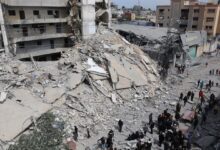Rafah exodus passes 810,000, says UNRWA
 At least 810,000 people have fled Rafah in just two weeks, UN humanitarians said on Monday amid reports of ongoing Israeli military operations in the southern city and in the north of Gaza.
At least 810,000 people have fled Rafah in just two weeks, UN humanitarians said on Monday amid reports of ongoing Israeli military operations in the southern city and in the north of Gaza.
“Every time families are displaced their lives are at serious risk. People are forced to leave everything behind looking for safety. But, there’s no safe zone,” the UN agency for Palestinian refugees, UNRWA, said in a post on X.
Accompanying the alert, images showed families with their belongings piled high on the back of cars and makeshift trailers; another photograph taken overlooking the coastline showed a mass of shelters for the displaced, all made out of simple sheeting and stretching all the way to the horizon.
According to the Gazan health authorities, at least 35,300 Gazans have been killed and more than 79,260 injured amid Israeli shelling since Hamas-led attacks in Israel on 7 October left some 1,250 dead and more than 250 taken hostage from southern Israel.
The latest data from UNRWA’s online logistics platform indicated that the delivery of humanitarian aid has stopped almost entirely via the main entry points to Gaza – the Rafah crossing and Kerem Shalom in the south.
Amid an escalation of military activity in eastern Rafah, no UN relief supplies reached the enclave on Sunday 19 May, and only 27 aid trucks entered via Kerem Shalom on Saturday, according to the UN agency portal, which also showed that only 33 additional aid trucks have used Kerem Shalom since 6 May, and none have entered via Rafah.
In the northwest of the enclave, the UN World Food Programme (WFP) reported that it has been using Erez west – also known as Zikim – to transport supplies and “try to get enough food to stop famine in its tracks”.
But, Matthew Hollingworth, WFP Country Director for Palestine, insisted that humanitarians needed additional entry points for aid.
“Every new entry point is a new artery, pumping lifeblood into Gaza, so we will work hard to continue to find new entry points and get more assistance in, at volume, consistently,” he said in the aid agency’s latest update.
Difficulty reaching the displaced
World Health Organization’s (WHO) Team Lead for Emergencies Communications, Nyka Alexander, recently visited Gaza and she noted in an interview on Monday with UN News that only a third of hospitals in Gaza – about 12 out of 36 – are functioning and constant fighting has made it difficult for healthcare workers to do their jobs.
It has become increasingly challenging to treat displaced people since they are constantly on the move.
“If there’s no continuity of care, who has your medical files? Who knows what treatment you need?” Ms. Alexander said.
Further, she said, the recent closings of crossings in Gaza, have forced medical staff to ration already limited medical supplies, putting additional stress on health workers.
She reiterated that nowhere in Gaza is safe and applauded humanitarian and healthcare workers who continue to work hard despite hugely difficult circumstances.
“It’s really moving, actually, to see how people, despite the fact that it’s not safe, are doing everything they can to help others,” Ms. Alexander said. Listen to the full interview below:
Soundcloud




